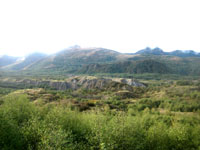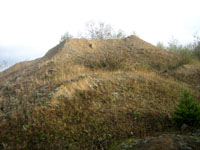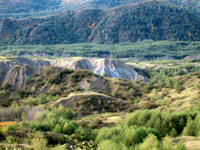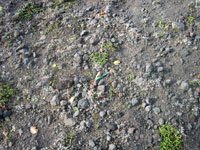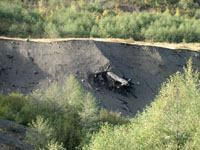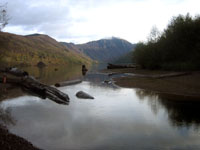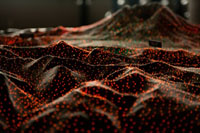The debris avalanche and Coldwater Lake
The first product of the 1980 eruption was a massive landslide, made up of three separate blocks (see Eruption Sequence). Instead of piling up in the valley between the mountain and Johnston Ridge, as one might expect. The landslide mass transformed into a debris avalanche -- a flow of large and small particles mixed with air. A part of this flow ran up over Johnston Ridge, but most of the material was deflected westwards along the valley of the North Fork of the Toutle River, where it came to rest. Its position is now marked by a wide area of hummocky terrain Fig. 1 and 1a). Total time for this event was only about 10 minutes.
 Fig 1a
Fig 1a
(courtesy google)
2.5 km3 of material ended up in the valley, consisting of a blocky facies -- remnants of the old mountain more or less intact -- and a matrix facies -- sandy deposits created by the penetration of landslide mass III by the lateral blast (Fig. 1a). The blocks underlie the individual hummocks (fig. 2) and the original material dictates the color of the hummock (fig. 3):
- pastel colors: altered dacite of Pine Creek age (3000-2500)
- black basalt: Castle Creek eruptive period (2300-1600)
- light-gray dacite: Goat Rocks eruptive episode (250-100)
Reddish hummocks are from altered andesites and dacites.
Texturally, the deposits have a median grain size that falls dominantly in the range 0.6 to 1.2 mm (Fig. 4 and 4a). They also contain an appreciable amount of wood (Fig. 5).

Sorting is poor within the matirx material and neither the sorting nor the median size of the matrix changes with position on the avalanche deposit. It would appear that there was minimal break-up and mixing during transport. Instead most of the dilation that occurred happenend on the mountain
Spirit Lake survived the eruption, although its elevation was dangerously increased and measures were taken to reduce the water level. A new lake was created in the Coldwater drainage by damming of the stream by the avalanche deposits (Fig 6), and there is an easily accessible hiking trail around the lake. A similar process produced Castle Lake (Fig. 7), which is not readily accessed but can be viewed from the Castle Lake overview. The nature and distribution of the avalanche deposits are well-laid out on the big model of the mountain in the Johnston Ridge Observatory visitor center (Fig. 8).

